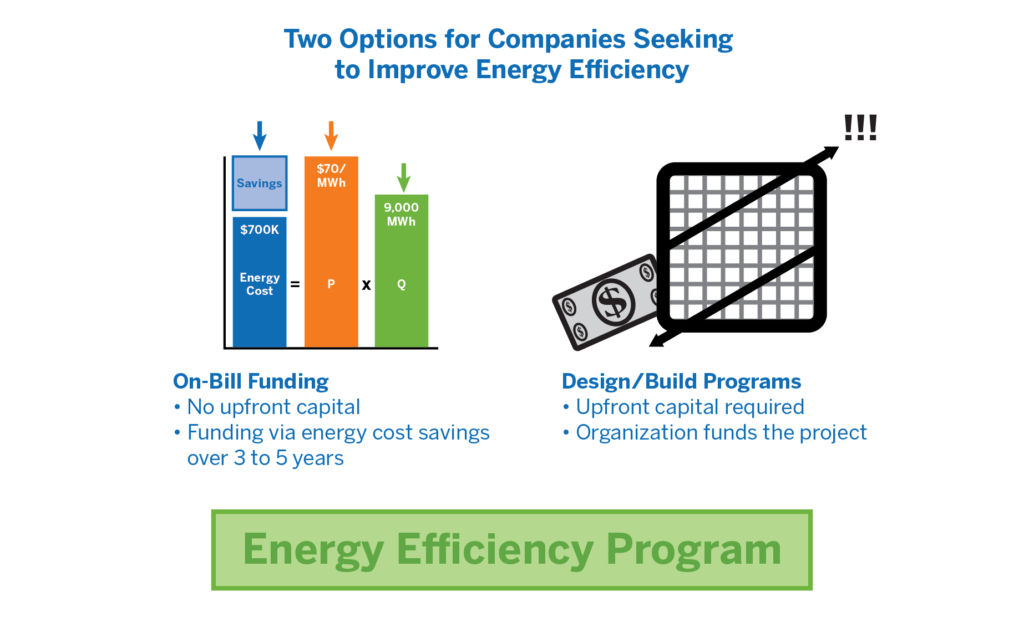Energy Efficiency Upgrades: Reducing Costs, Meeting State-Mandated Goals
3 min readIn light of the economic downturn experienced this year, many businesses across the country are looking to reduce energy costs. Energy efficiency upgrades are one way in which a business can both lower its energy bill and contribute to the positive momentum of carbon emissions reductions currently being experienced across the globe. However, implementing efficiency measures may be challenging when upfront capital, expertise, and resources are limited or unavailable.
So, given the constraints on financial and technical resources, how can an organization gain control of their energy usage and lower their energy cost?
Today, many businesses can avail themselves of a variety of options to overcome these limitations including design/build programs and on-bill funding programs. The on-bill funding option is suited for customers whose capital and timeframes are tight and when short-term results and simplicity are required.
On-bill funding allows the customer to fund the cost of energy efficiency upgrades and recoups the cost as a line item on a commodity (i.e., the power and/or gas) contract. This allows companies to more easily realize total energy cost savings and meet sustainability goals by reducing energy consumption over time using their current energy budget.
Many companies find on-bill funding as a means to achieve corporate compliance with regulatory requirements, meet established sustainability goals, improve electricity load profile, realize energy cost savings, increase asset valuation and reduce operation and maintenance (O&M) costs.

Through on-bill funding, companies can also replace aging equipment with ENERGY STAR®-rated equipment or improve their ENERGY STAR rating which, in many markets, can help establish a competitive market advantage or meet the requirements of their stakeholders. For example, a law in Washington, D.C. requires commercial and multifamily buildings to meet or exceed the District’s median ENERGY STAR score for each property type or face alternative compliance penalties with reporting to begin in 2021. Learn more about this requirement.
The Benefits of On-Bill Funding
- No upfront capital or financing is needed; this preserves the organization’s capital budget.
- The cost of the energy efficiency upgrades is included on the organization’s electricity or gas commodity bill.
- The energy service company may offer one-year warranty coverage on the entire installation — and even longer warranties may be available on some equipment. This warranty, combined with the longer life of the new assets, is expected to yield additional maintenance savings for many years.
- The organization owns the energy efficiency equipment from the start of the contract and retains the full benefit of the energy efficiency measures at the end of the contract.
The energy efficiency measures that are typically employed in this approach include projects that provide rapid payback periods with relatively low capital investments. Some typical efficiency measures for on-bill funding include:
- LED lighting (e.g., Germicidal ultraviolet (UV) lighting may be a common installment in businesses that wish to take further precautions to prevent spread of communicable disease.)
- HVAC and cooling (The Environmental Protection Agency recommends modifying ventilating, cooling and heating systems to increase minimum efficiency reporting value (MERV) levels and increase use of outdoor air, among other methods, to reduce the spread of COVID-19.)1
- Building automation controls
- Motor replacement with high efficiency motors and utilization of variable frequency drives
However, efficiency and renewable energy measures can also include higher capital cost projects and don’t always require a positive cash flow. These may include:
- Boilers
- Chillers
- Solar
- Back-up /emergency generation
- Submetering and monitoring equipment
How One Customer is Using EME
Kloss Distributing Company is one company that took advantage of on-bill funding for energy efficiency initiatives. Through the implementation of both a lighting and solar solution, the customer is able to reduce carbon emissions in both new and existing buildings with the help of Constellation’s on-bill funding mechanism known as Efficiency Made Easy or EME. In addition to EME, Constellation assisted Kloss in finding a combination of state, federal, and utility incentives to afford the installation of solar panels to generate onsite electricity.
To understand how on-bill funding works, contact your Constellation sales representative. For more information on our Efficiency Made Easy solution, visit www.constellation.com/EME.
Reference

